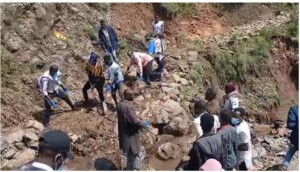Torrential rains, floods kill 12 in Sudan
On Saturday, nine people drowned in the Hallouf valley in El Fasher locality in North Darfur. On Sunday, two people were killed in Khartoum when their houses collapsed. In En Nahud in West Kordofan, a man was killed by a flash flood.
On Saturday, nine people drowned in the Hallouf valley in El Fasher locality in North Darfur. On Sunday, two people were killed in Khartoum when their houses collapsed. In En Nahud in West Kordofan, a man was killed by a flash flood.
Heavy rainfall in the areas east and north of El Fasher, capital of North Darfur, led to the flooding of Hallouf valley, west of the town, and Sowelenga valley that runs through El Fasher.
The Commissioner of El Fasher locality, El Tijani Abdallah Saleh, told reporters on Saturday evening that nine people were found drowned.
In En Nahud in West Kordofan, a man was swept away in a flash flood, and died,” a listener reported from En Nahud.
Transport
The heavy rainfall also caused many buses to halt their services between the city’s districts. “Thousands of people waited in vain for their buses. Bus stations were overcrowded, while those bus owners and drivers who did work, doubled the tariffs,” a listener told Radio Dabanga from Omdurman, the sister-city of Khartoum.
A Khartoum bus owner complained to this station about “the negligence of the authorities” concerning the drainage system in the capital. “We were forced to stop our services to protect our vehicles, as many streets are flooded,” he explained.
Loss of homes
In the Sudanese capital Khartoum, two people died when their houses collapsed as a result of torrential rainfall on Saturday morning.
The Sudanese Red Crescent Organisation further announced that the Khartoum rains destroyed 124 houses and ten latrines entirely and 105 houses partially.
Heavy rains also ravaged the town of En Nahud in West Kordofan on Friday and Saturday.
A listener reported from En Nahud that “Mohamed Suleiman drowned in a flash flood in El Safa district. The floods also swept away nine vehicles”.
He added that 156 houses, built of mud bricks, collapsed. He appealed to the state authorities and humanitarian organisations to provide relief to the affected, and repair and extent the drainage system “as soon as possible”.
In Sheikan locality in North Kordofan, 864 people were affected by the rains, after 30 houses collapsed, and 114 houses were damaged.
The director of the North Kordofan Rainy Season Emergency Authority, and head of the Police Fire Brigade, Brig. Abdelgadir Mohamed Saleh, described the preparations for the rainy season as weak.
Saleh told the press in Sheikan that, according to meteorological indicators, North Kordofan will witness heavy rains this year. He stressed the authorities’ inability to provide aid to the people in the event of a disaster.
Risk of flooding
There is an 80 per cent change of above average to average rainfall over the 2016 rainy season (June to September/October), the Sudan Meteorological Authority (SMA) reported recently. The Famine Early Warning Systems Network (FEWS Net) has identified a 55-70 per cent chance of the La Niña (the counterpart of El Niño) climatic phenomenon occurring in Sudan by the end of 2016, with increased risk of flooding across the country.
The UN Office for the Coordination of Humanitarian Affairs (OCHA) in Sudan reports in its latest weekly bulletin that flash floods and heavy rains in June have already damaged and destroyed more than 2,500 houses in Sennar State, reportedly affecting almost 15,000 people so far. The Sudanese Civil Defence and the Red Crescent Society have provided an initial response to the affected people.
Flooding has also been reported in parts of Blue Nile, White Nile and Gedaref states. According to HAC, State Emergency Committees have been activated in Blue Nile, El Gezira, North Kordofan, River Nile, Sennar and White Nile states.
Flooding in Sudan normally occurs from June to October, and according to the World Food Programme (WFP) and Food and Agriculture Organization (FAO) El Niño Seasonal Calendar, flooding in parts of East Africa including Sudan may occur from July to November this year.
Positive impact
FEWS Net anticipates average to above-average 2016-2017 crop production and pasture conditions in Sudan, with positive impacts to food security for poor rural families through improved household food production, access to seasonal wild foods, purchasing power, and availability of livestock products.











 and then
and then